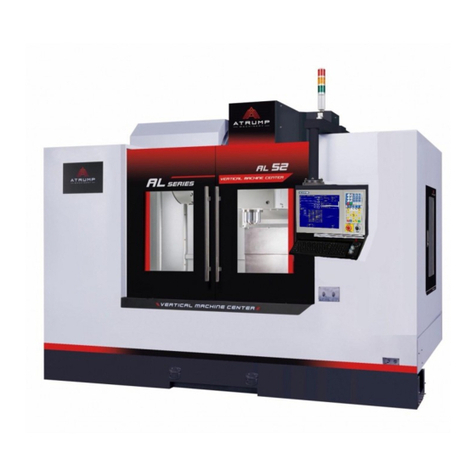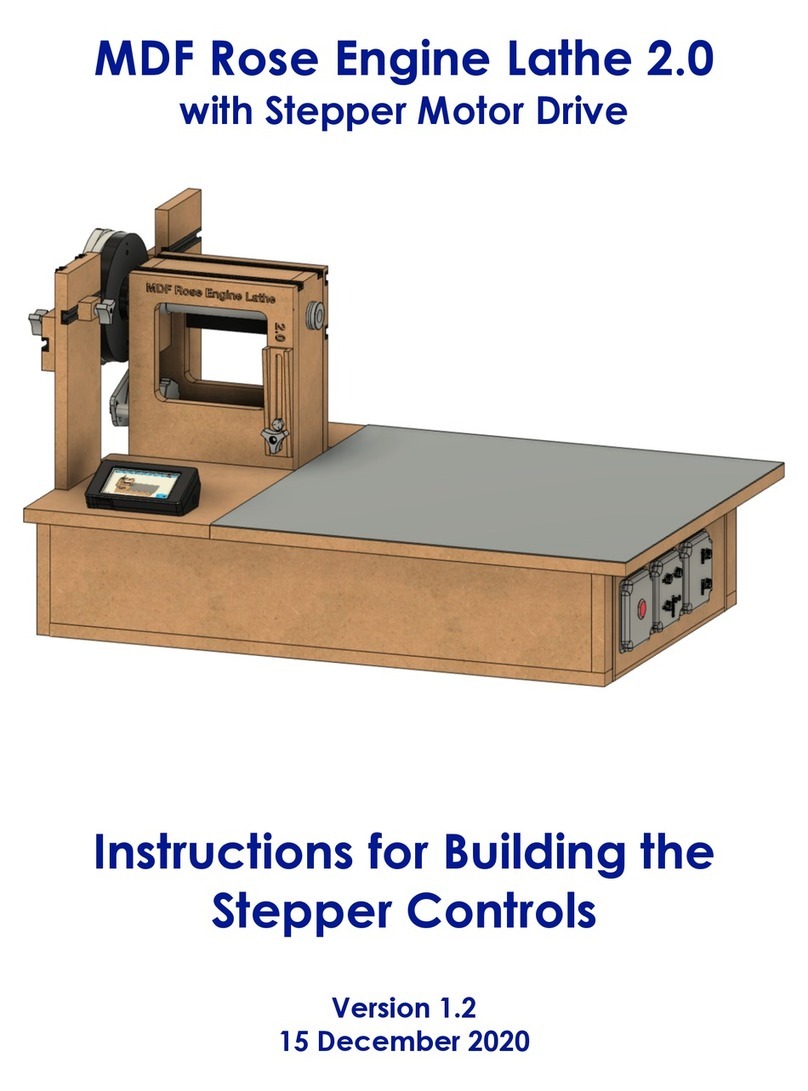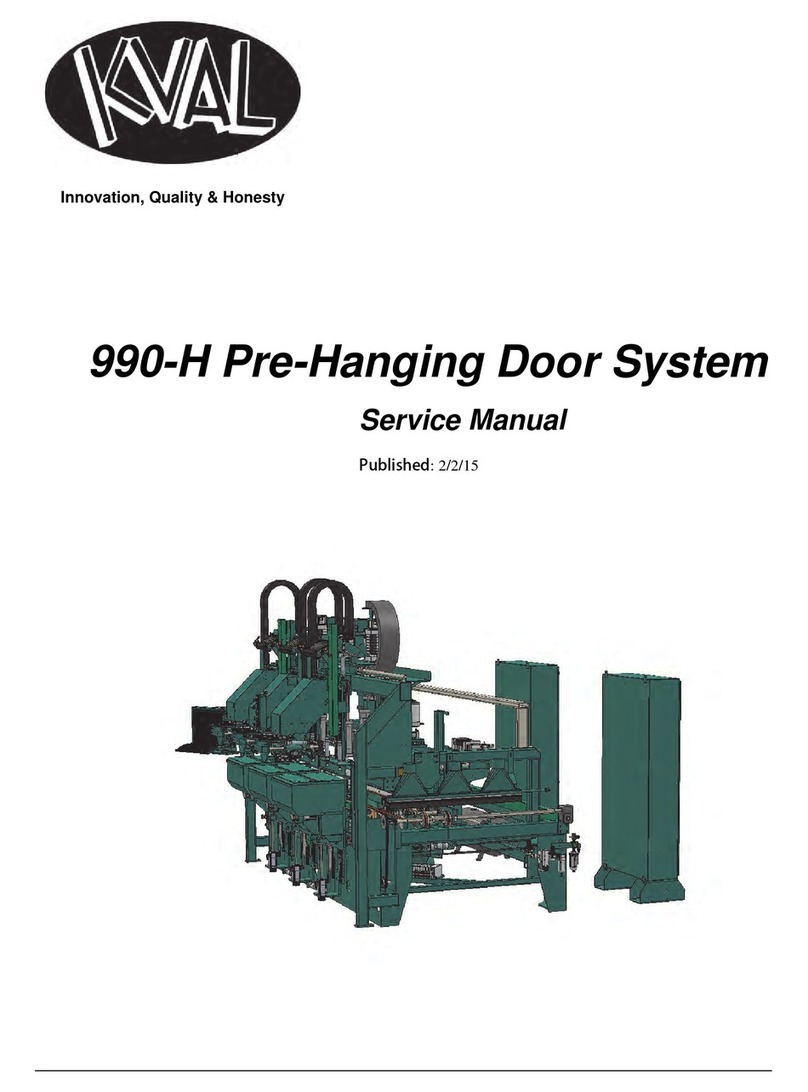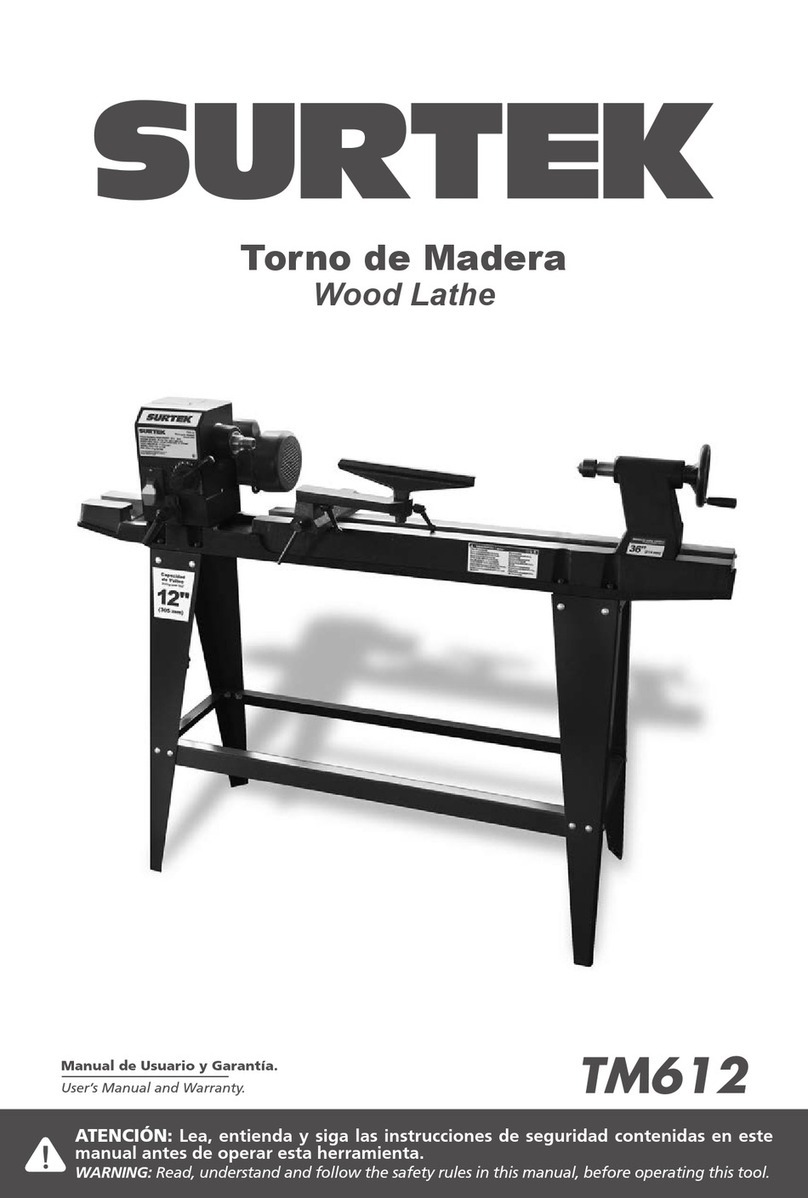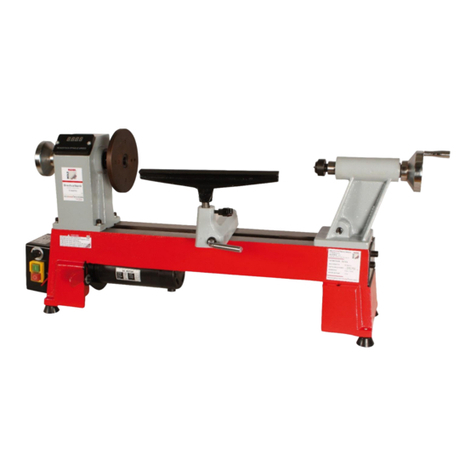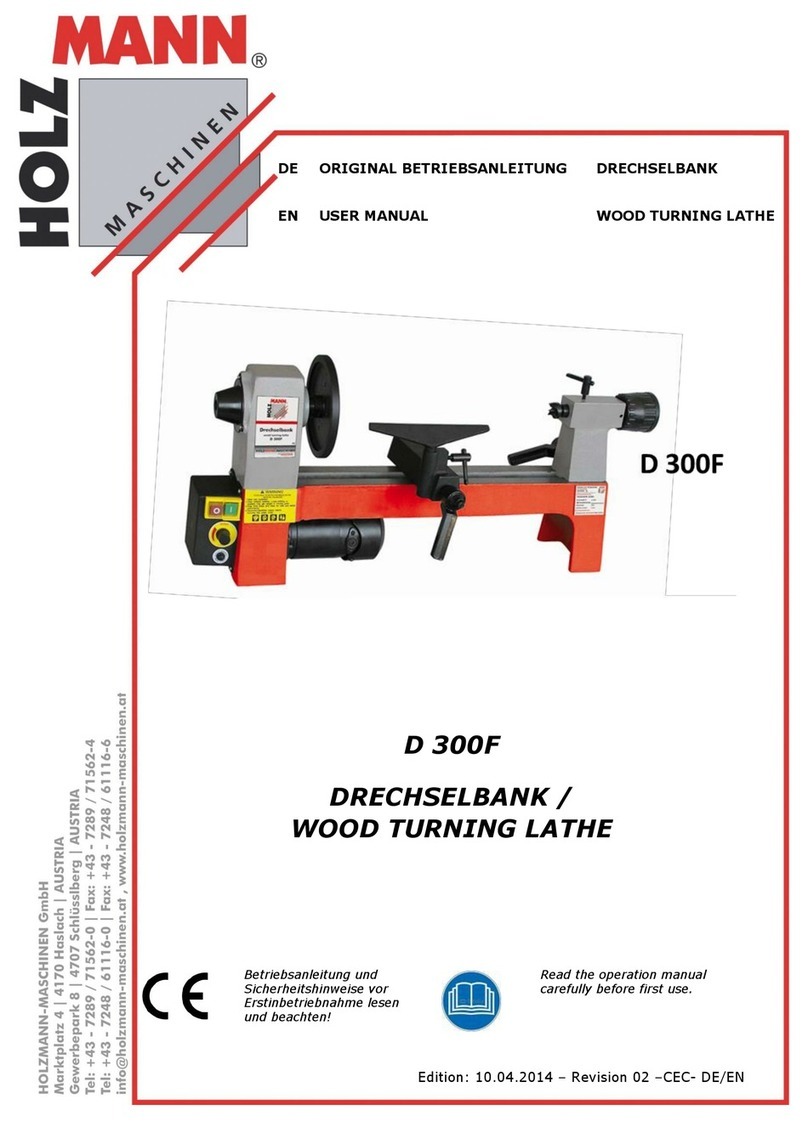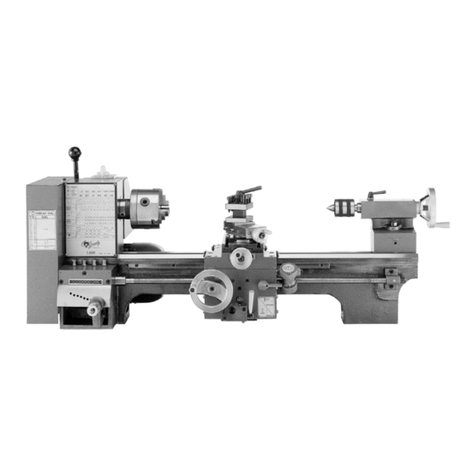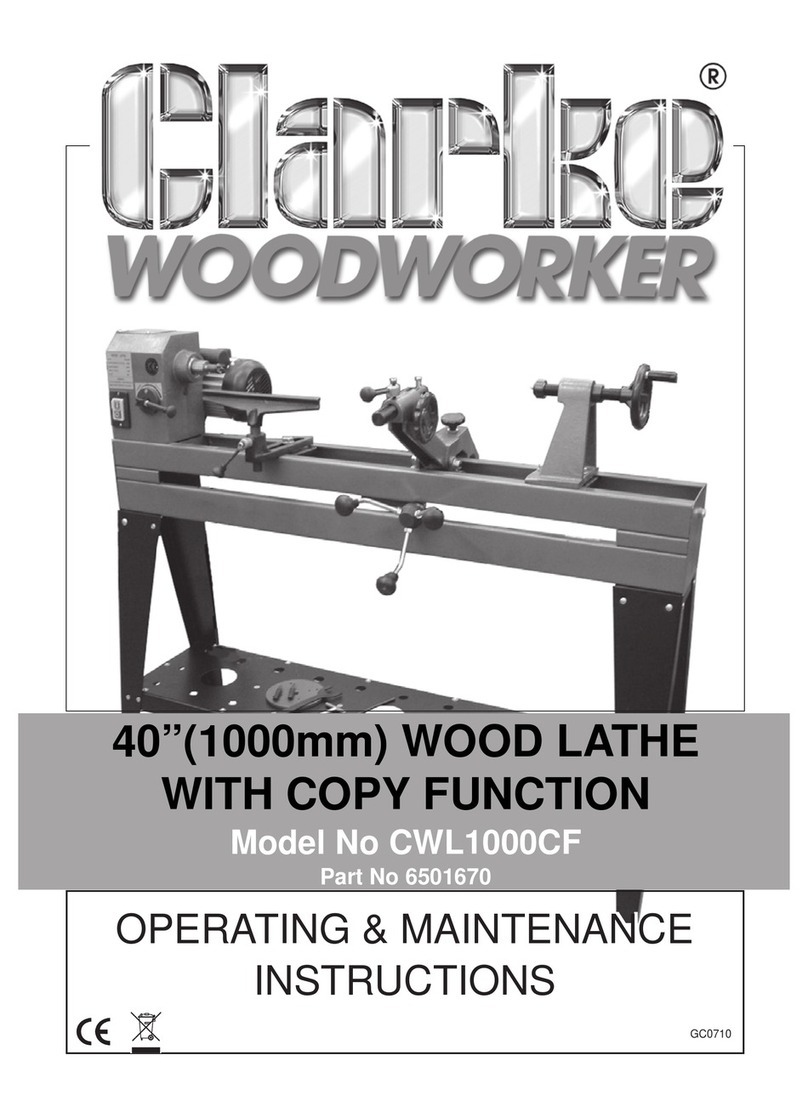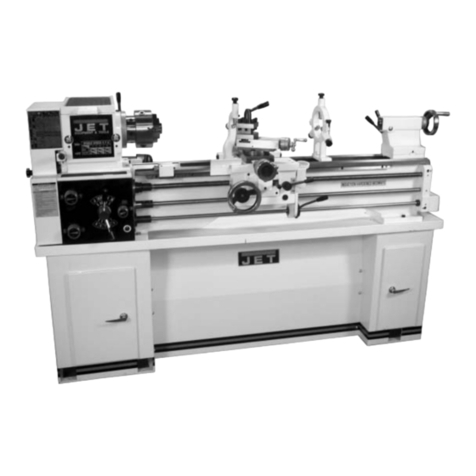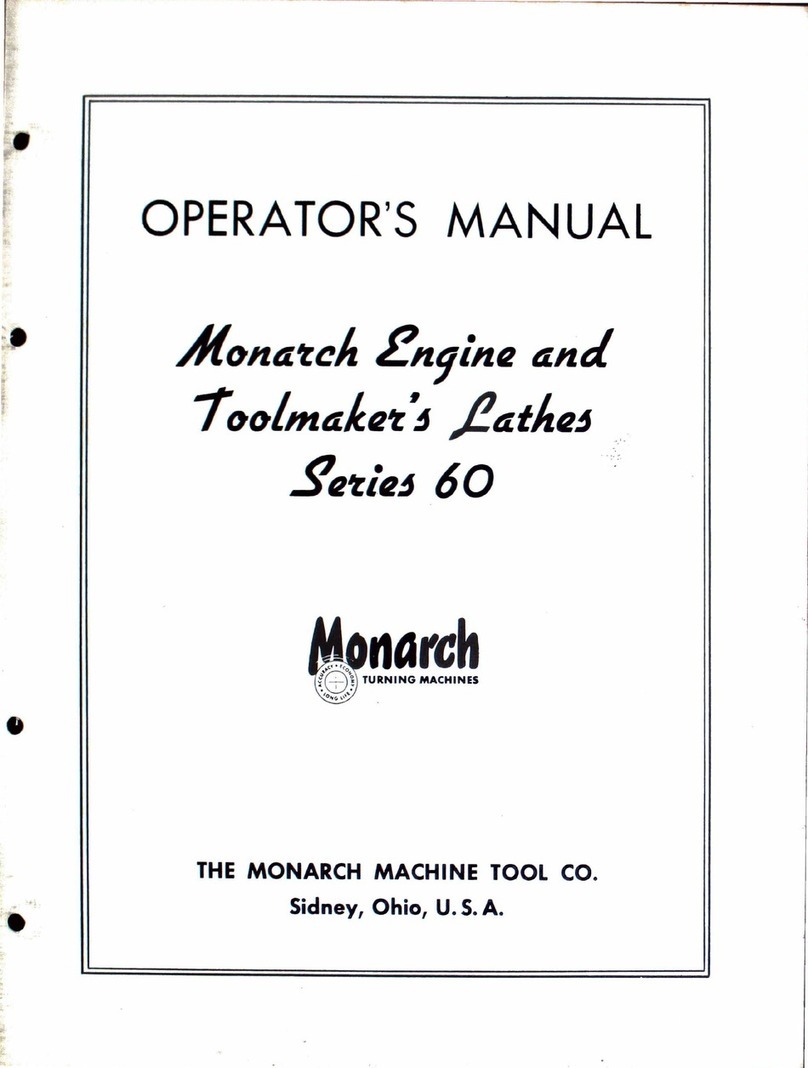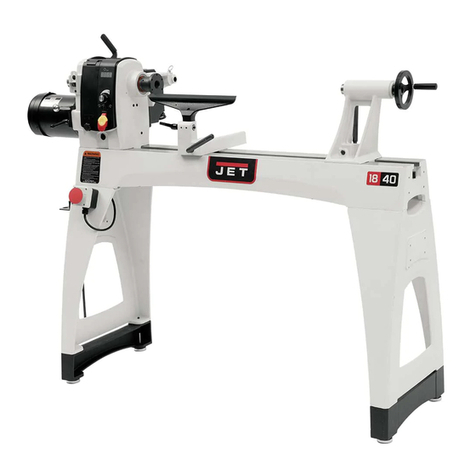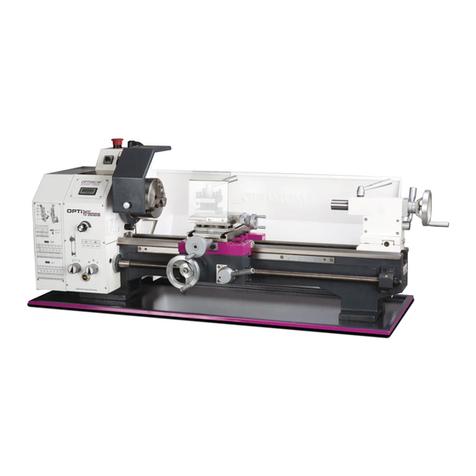Atrump KL Series Installation and operation manual

鼻
ATRMP
MAC HIN ERY
KL 洹匣
Operator's Manual
& Parts List

Content
1
SAFETY INSTRUCTIONS …………………………………………………..……….
P
1-1
1.1
General safety instructions for operating the machine ……………………………
P
1-2
1.1.1
Safety instructions for work holding ………………………………………….
P
1-4
1.2
Maintenance safety instruction ………………………………………………………………
P
1-6
1.3
Installation precautions ………………………………………………………………………...
P
1-6
1.3.1
Wiring ……………………………………………………………………………………….
P
1-6
1.3.2
Grounding …………………………………………………………………………………
P
1-7
1.3.3
Environmental conditions …………………………………………………………
P
1-8
1.4
Safety precaution …………………………………………………………………………………….
P
1-8
1.4.1
Before switching on ………………………………………………………….………
P
1-10
1.4.2
Routine inspections ………………………………………………………….………
P
1-11
1.4.3
Warm up …………………………………………………………………………….….…
P
1-11
1.4.4
Preparations …………………………………………………………………….…….…
P
1-11
1.4.5
Operation ……………………………………………………………………………………
P
1-12
1.4.6
To interrupt machine ……………………………………………………………….…
P
1-13
1.4.7
Completing a job …………………………………………………………………….…
P
1-14
1.4.8
Safety devices ………………………………………………………………………….…
P
1-14
1.4.9
Maintenance operation preparations …………………………………………
P
1-14
1.4.10
Maintenance operation …………………………………………………………
P
1-15
1.4.11
Unit operation is begun after maintenance ……………………………….
P
1-16
1.5
Warning signs plate on the machine …………………………………………………….
P
1-16
1.6
Hazard List and Solution …………………………………………………………………………
P
1-19
2
MACHINE SPECIFICATIONS ………………………………………………………………………
P
2-1
2.1
Dimensional drawing ………………………………………………………………………………
P
2-2
2.1.1
Main features ……………………………………………………………………………
P
2-2
2.1.2
General layout ……………………………………………………………………………
P
2-3
2.1.3
Specification ………………………………………………………………………………
P
2-4
2.1.4
Interrupted diagram of tool rack…………………………………………………
P
2-5
2.2
Check list ………………………………………………………………………………………………
P
2-7
2.2.1
Check list for operation ………………………………………………………………
P
2-7
2.2.2
Check list for maintenance ……………………………………………………….
P
2-7
3
INSTALLATION ……………………………………………………………………………………………
P
3-1
3.1
Foundation ………………………………………………………………………………………………
P
3-2
3.1.1
Foundation Layout ………………………………………………………………………
P
3-3
3.1.2
Layout & Floor Plan ………………………………………………………………………
P
3-5
3.2
Connection of power line ……………………………………………………………………….
P
3-6
3.3
Unpacking ………………………………………………………………………………………………
P
3-6

Content
3.3.1
Checking for shortage …………………………………………………………………
P
3-6
3.3.2
Machine Lifting ……………………………………………………………………………
P
3-7
3.3.3
Machine Placing ……………………………………………………………………………
P
3-/
3.3.4
Machine Clean & Lubrication ………………………………………………………
P
3-8
3.4
Machine Leveling ……………………………………………………………………………………
P
3-9
3.5
Lubrication ………………………………………………………………………………………………
P
3-10
3.5.1
Lubrication pump specification ……………………………………………………
P
3-10
3.5.2
Lubrication System ………………………………………………………………………
P
3-11
3.5.3
Lubrication system on Headstock ………………………………………………
P
3-13
3.5.4
Lubrication on tailstock ………………………………………………………………
P
3-13
3.6
Chucks and chuck mounting ……………………………………………………………………
P
3-14
3.6.1
Chuck fitting on D1-6 spindle nose ………………………………….…….……
P
3-14
3.7
Tailstock center loading & unloading ………………………….…………………….……
P
3-14
3.8
Coolant ……………………….…….……………………………………………………….…….……
P
3-14
4
MAINTENANCE ………………………….…….……………………………………………….…….……
P
4-1
4.1
Lubrication System ………………………….……..……………………………..….…….……
P
4-2
4.1.1
Replacing headstock Oil ………………………………………………….…….……
P
4-2
4.1.2
Fittings ………………………….…….…………………………………….….….….……
P
4-3
4.2
Machine body ………………………….…….…………………………………………….…….……
P
4-3
4.2.1
Headstock ………………………….…….…………………………………….…….……
P
4-3
4.2.2
Cross-slide ………………………….…….……………………………….……..………
P
4-4
4.2.3
Saddle ………………………….…….………………………………………….….….……
P
4-5
4.2.4
Aligning tailstock to spindle ……………………………………………..…….……
P
4-6
4.2.5
Adjusting belt tension of X-axis ………………………….……………..….……
P
4-6
4.3
Electric equipment ………………………….…….…………………………………….…….……
P
4-7
4.3.1
Motor ………………………….…….…………………………….………………..….……
P
4-7
4.3.2
Control units ………………………….…….…………………………….…….……
P
4-7
4.3.3
Wire connectors ………………………….…….……………………….…….…….…
P
4-7
4.4
Simple trouble shooting ………………………….…….……………………………….…….…
P
4-7
4.5
Remove chip and renew coolant ………………………….…………………………….……
P
4-8
4.6
Notice for maintenance and inspection ……………………………………….…….……
P
4-9
4.7
Maintenance and Inspection List ………………………….……………………..….……
P
4-12
5
CHUCK…………………………………………………………………………………….…………………
P
5-1
5.1
Instruction Manual……………………………………………………………………………..
P
5-2
5.1.1
Safety precautios…………………………………………………………………….
P
5-2
5.2
Installation of chuck…………………………………………………………………………..
P
5-4
5.3
Maintenance and Inspection…………………….…….…………………………………
P
5-5
5.4
Trouble shooting………………..…..…………………………….…….……………………
P
5-5

Content
5.5
Independent chuck……………………….……………………………………………………
P
5-6
6
PARTS LIST ………………………………………………………………………………………….……….
P
6-1
6.1
Headstock ………………………………………………………………………………………………
P
6-2
6.1.1
Parts list of headstock.…………………………………………………………………
6.2
X-axis Transs .…….…..………………………………….….…….…….………………………...
P
6-7
6.2.1
Parts list of 42CS Saddle.......................................................
6.3
Z-axis Transs. .…….…..………………………….…….…………………………………………
P
6-11
6.3.1
Parts list of 42CS BED..............…………………………….…….………………
6.4
Tailstock Oil Motor.…….…..…………………….…….….…….…….………………………..
P
6-13
6.4.1
Parts list of 50CT tailstock (Oil Motor)…………………….…….…………..
6.5
Hydraulic Circuit Diagram……………………….…….…………………………………………
P
6-17
WARNING
Persons unable to read English must have this manual read and
explained to them before operating or maintaining the machine.
Everyone working on the machine must know how to operate it safely
and correctly to avoid possible injury.

1- 1
1.
SAFETY INSTRUCTIONS

1- 2
1. SAFETY INSTRUCTIONS
WARNING
Do not install, operate, or service this machine until:
1) You have read and understand the safety instructions on the pages that
follow.
2) You have read and understand the operator’s manual, especially knowing the
function and location of all machine controls and read manuals for any
related accessories.
3) You have read and understand all safety and instruction plates attached to
the machine and it’s related accessories.
4) Prior to install or services the machine read and understand the maintenance
manual.
5) To service the machine must be done only by competent and trained
personnel.
NOTICE
The following safety instructions are general recommendations for most
common operations on a turning machine.
Additional safety measures may be required for your particular application.
Therefore, makes no warranty or representation as the absolute correctness of
sufficiency of the instructions.
1.1 General safety instructions for operating the machine
1) The best defense against injuries on a turning machine is to be alert. Never
initiate a machine function unless you completely understand what the
function will cause the machine to do.
2) Never operate the machine with any cover or shield opened or removed.
3) Never reach into the work area when the spindle is rotating or if the machine
is in automatic mode.
4) Put the machine in manual mode and be sure last programmed function has
been Completed before reaching inside of the work area.
5) The functions of the machine make it impossible to eliminate all pinch points.
Be particularly aware of the following pinch points:

1- 3
* Spindle and chuck rotation
* Indexing of turret and tools
* Carriage and cross-slide movement
* Tailstock movement, both quill and body
6) Keep machine and area around it clean and well lighted. Never allow chips ,
coolant or oil to remain on the floor. Do not leave loose objects on around
machine.
7) Clothing :
* Wear safety glasses with eye shields at all times. Protect your eyes. Never
use a compressed air house to remove chips from a machine.
* Never wear loose fitting clothing. Remove all jewelry (rings, watches,
necklaces…etc.). They can be caught in moving parts of the machine.
* Gloves are easily caught in moving parts. Take them off before turning the
machine on.
* Always wear safety shoes with steel toes and oil-resistant soles.
* Wear a safety helmet when working near overhead hazards.
* If operator has long hair, hair should always be tucked under a cap or tied
back and up.
8) Turning machine are designed to be run by one person. Persons other than
the designated operator should stay out of the machine area during
operation.
9) Take care, not to bump or accidentally touch the machine control. Doing so
can initiate an unintended machine movement which could cause an injury
or a wreck.
10) Do not paint, alter, deface or remove any warning plates from the machine.
11) Report any loose, worn or broken parts to your supervisor. The same action
should be taken if any unusual noise or machine action occurs.
12) Never operate the machine after taking strong medication, using
non-prescription drugs, or consuming alcoholic beverages. Persons with
illness, which might cause dizziness or fainting, should never operate this
machine.
13) The electric components are protected from normal moisture resulting from
humidity use of water base soluble coolant, etc. Do not, however, use water
house to clean the machine or the area around it.
14) Never touch a machine control device or electrical component when your
hand is wet. Keep flammable liquids and materials away from the work
area and chips.
15) Never clean up chips while the machine is running or is in automatic mode.
16) Do not file work pieces being rotated under power.
17) At the end of the work day the machine should be placed in either “control

1- 4
off” or “power off” modes.
18) When restarting a machine after it has been shut down, always assume it
has been tampered with. Recheck all phases of the job as though you were
running the first piece.
19) Never touch spindle start or spindle jog control until hands, feet, and body
are well clear of the work area.
20) Coolant and oils can make surfaces on the machine slippery. They can also
present an electrical hazard if the machine has power on. For these reasons
do not stand on any part of the machine at any time.
21) Never extend an unsupported bar out of the rear the spindle or hydraulic
cylinder a distance from a concentric support more than 10 times of it’s
diameter. Doing so can cause the bar to bend or break. When any bar is
extended, a large sign should be placed to warn people to stay away from
the area.
22) If your turning machine has a bar-feeder interfaced to it , keep yourself and
others away from the exit end of the bar-feeder when the machine running.
1.1.1 Safety instructions for work holding
1) Never run a job on this machine until you are 100% sure the work piece is
being held in such a manner as withstand the centrifugal force from rotation
and cutting forces of the tooling. If there is any doubt , whatever , consult
with your supervisor.
2) A chuck is the most common work holding device used on this machine.
Some of the factors affect the holding device used on this machine. These
factors which affect the holding ability of a chuck are :
* Clamping force of jaws
* Rotational speed of the spindle
* Type of jaw surface (serrated , smooth , etc.)
* Area of chuck configuration of the work piece…shape, weight, and balance
* Jaw weight and location
3) With air or hydraulic actuated power chuck (optional accessory) , make sure
the jaws are gripping the work securely before they reach the end of their
travel. When using a power chuck, check the hydraulic or air pressure before
every operation. Low chucking pressures will diminish jaw-dripping force,
which may allow the work piece to come out of the jaws. Excessive pressure
can damage a power chuck, which could cause a loss of jaw force. The
gripping force of a power chuck can be diminished as much as 50% because
lack of lubrication or lack of periodic cleaning. Components of the chuck are
subject to wear and damage which also can lessen gripping power. Grease

1- 5
the chuck at the beginning of every shift. Use only the chuck
manufacturer’s recommended lubricant.
A. A weekly examination of the condition of chuck should be made. This
examination should include the measurement of jaw clamping force with
a jaw force gage to insure that the chuck is function , as it should.
B. Refer to manufacturer’s manual for chuck and cylinder for any other
maintenance requirements. As the spindle R.P.M. increase the gripping
force of the jaw decreases. The larger the chuck diameter the more loss
becomes. Various types of top jaws are serrated contact surfaces on
work piece. Improper usage could cause serious injury or death.
Remember-chucking a work piece safely involves many variables. If you
have the slightest doubt regarding the safety of your set-up for a job ,
consult with your supervisor.
4) Never operate spindle-mounted accessories over their rated speed. If the
chuck or accessory is not supplied by original maker, verify the safe
operating speed with the manufacturer.
5) Always be sure the chuck the chuck or accessory is located correctly on the
spindle nose and it is securely bolted the face of the spindle.
6) Be sure any item bolted or clamped to a chuck or fixture is securely fastened
before starting the spindle.
7) Proper lifting equipment should be used for heavy chucks, fixtures, and work
pieces.
8) Always is aware f that closing chuck jaws could trap fingers or hands.
9) The same safety instructions that apply to power chucks also apply to
manual operated chucks. The following additional precautions should be
taken when using a manual chuck :
A. Always use spring-loaded, self-ejecting type safety wrenches.
B. Never put an extension bar on a chuck wrench or hit with hammer.
C. Never run a gear scroll chuck without having something chucked in the
jaws. Centrifugal force can cause the scroll to unwind if the chuck is
empty. If this occurs, the jaws may come out of the chuck while the
spindle is turning.
10) If a work piece is extended from the chuck a distance of 3 to 4 times its
diameter, without being supported by the tailstock, poor cutting condition
will normally occur. Under no circumstances extend an unsupported work
piece more than this amount without supporting the work piece with the
tailstock. Doing so can cause the part to bend or break.

1- 6
1.2 Maintenance safety instruction
WARNING
High voltage is used to power the machine; only authorized electricians should
Correct any electrical component failure. Disconnect main power and lock in off
position before attempting any repair. Tag disconnect switch “DO NOT START”
1) Read and understand safety instructions for machine operator before
servicing this machine.
2) Know all points where high voltages are present on this machine and in
electrical boxes.
3) Residual voltages can exist in electrical cabinets for a period of time after
power has been turned off. Check any component inside cabinet with a meter
a before touching.
1.3 Installation precautions
To ensure the safe operation of the NC machine, note the following during
installation.
1.3.1 Wiring
1) Be sure to use electrical conductors with performance ratings equivalent or
superior to those described in the Maintenance Manual.
2) Do nut connect to the power distribution panel any power cables for device,
which can cause Line noise, such as ,are welders and high frequency
quenching machines.
3) Arrange for a qualified engineer to connect the power lines.
1.3.2 Grounding
Use a grounding wire with a cross section of more than 14 mm and a resistance
to ground of less Than 100 ohms.
This wire size should be greater than AWB (American Wire Gauge) No. 5 and
SWG (British Legal Standard Wire Gauge) No.6.

1- 7
Generally, the NC machine should be ground to a separate grounding rod. If an
independent ground cannot be provided for the machine, prepare the ground
connection as follow:
1) Connect a single conductor to it’s own grounding terminal. This will avoid
possible serious accidents resulting from ground currents ,which might
otherwise flow in the NC machine if a peripheral device , should malfunction.
2) Be careful when using concrete reinforcing rods as grounding points. These
reinforcing rods often are used to ground equipment because they usually
offer a resistance to ground of less than 100 ohms. In doing so, make the
connections as follow:
A. Do not use the same grounding-reinforcing rod or grounding terminal for
other devices since this could lead to line noise such as produced electric
welders and high frequency quenching machine.
B. Use a grounding terminal with an adequate electrical performance rating
and which is durable.
3) A separate grounding wire should be used, one whose length is as short as
possible.
4) Check the resistance to ground by actual measurement. This should
measure less than 100 ohms if the single device is connected to its own
grounding rod.
Desirable Independent Grounding:
Common grounds:
Never ground equipment as shown in the left side figure (FORBADE ) :
Earth resistance: Less than 100 ohms
Resistance to ground = 100 the number
of devices connected to the grounding
(Ω)

1- 8
(Wrong Grounding)
1.3.3 Environmental conditions
Generally, the machine will be installed on the following conditions. However,
these may change over a period of time or in response to seasonal changes.
1) Supply voltage : 90% to 110% of nominal supply voltage
2) Source frequency : ± 2hz of nominal frequency
3) Ambient temperature : 0℃to 45℃(32℉to 113℉)
4) Relative humidity : Less than 80%
Temperature changes should not cause condensation.
5) Atmosphere : Free from excessive dust, acid fumes corrosive
gases and salt
6) It should be avoided to expose the machine to direct sunlight or heat rays
which can change the environmental temperature.
7) Avoid exposing the NC machine to abnormal vibration.
If it is difficult to observe meet these conditions, contact us immediately.
1.4 Safety precaution
This machine is provided with a number of safety devices to protect operator
and equipment from being injured and damaged. Operators should not,
however, rely solely upon these safety devices but should operate the machine
after fully understanding what special precautions to take by reading the
following remarks thoroughly.
Basic operating practices
DANGER
1) Some control panels, transformers, motors junction boxes and other parts
have high-voltage terminals, these should not be touched or a severe electric

1- 9
shock will be sustained.
2) Do not touch a switch witch wet hands. This, too, can cause an electric
shock.
WARNING
1) The emergency stop push-button should be well known so that it can be
operated at any time without having to look for it.
2) Before replacing a fuse, switch off the machine.
3) Provide sufficient working space to avoid hazardous. To prevent accidents all
floors should be dry and clean.
4) Water or oil can make floors slippery and hazardous. To prevent accidents all
floors should be dry and clean.
5) Before operating switches, always check that they are the right ones.
6) Never touch a switch accidentally.
7) Workbenches near the machine must be strong enough to prevent accidents.
Articles should be prevented from slipping off the bench surface.
8) If a job is to be done by two or more persons, coordinating signals should be
given at each step of the operation. Unless a signal is given and
acknowledged, the next step should not be taken.
CAUTION
1) In the event of power failure, turn off the main circuit breaker immediately.
2) Use the recommended hydraulic oils, lubricants and grease or acceptable
equivalents.
3) Replacement fuses should have the proper current ratings.
4) Protect the NC unit, operating panel, electric control panel, etc. from shocks,
since this could cause a failure or malfunction.
5) Do not change parameters, values and other electrical settings
unnecessarily. If such changes are unavoidable, record the values prior to
the change so that they can be returned to their original settings if
necessary.
6) Do not soil, scratch or remove the caution plate. Should it become illegible
or be missing, order another caution plate from the surlier. (Specifying the
part number shown at the lower right of the plate.)

1- 10
1.4.1 Before switching on
DANGER
Cables, cords or electric wires whose insulation is damaged can cause current
leaks and electric shocks. Before using these, check their condition.
WARNING
1) Be sure the instruction manual and the programming manual are fully
understood. Every function and operating should completely clear.
2) Use safety shoes, which are not damaged by oil, safety goggles with side
covers, safe clothes and other safety protection.
3) Close all electric cabinet doors, operating cover, fully guarding door before
switching machine on.
CAUTION
1) The power cable form the factory feeder switch to the machine main circuit
breaker should have a sufficient sectional area to handle the electric power
used.
2) Cables which have to lie on the floor must be protected against chips so that
short-circuits will not occur.
3) Each sliding part must be freshly lubricated before starting to operate the
machine after unpacking or keeping the machine idle for a long period
(several or more). For the lubricating and so forth, keep lubricating oil pump
working until oil oozes out form wiper. Contact our Service Station in
connection with what procedure should be taken since it depends on the type
of machine.
4) Oil reservoirs should be filled to indicate levels, check and add oil, if
necessary.
5) For lubricating points, oil brands and appropriate levels, see the various
instruction plates.
6) Switches and levers should operate smoothly.
7) Check the coolant level, and add coolant, if necessary.
8) When switching the machine on, connect the factory feeder switch to the
machine circuit breaker, and then turn power switch to the ON position in
order

1- 11
1.4.2 Routine inspections
WARNING
When checking belt tensions, do not get your fingers caught between the belt
and pulley.
CAUTION
1) Check pressure gages for proper readings.
2) Check motor, gearboxes and other parts for abnormal noises.
3) Check the motor lubrication, and sliding parts for evidence of proper
lubrication
4) Check safety covers and safety devices for proper operation
5) Check belt tensions. Replace any set of belts that has become stretched with
a fresh matching set.
1.4.3 Warm up
1) Warm up machine, especially the spindle and feed shaft by running them for
10 to 20 minutes at about half or one-third the maximum speed in the
automatic operation mode.
2) This automatic operation program should cause each machine component to
operate. At the same time check their operations.
3) Be particularly careful to warm up the spindle, which can turn up to 3500rpm.
If the machine is used for actual machining immediately after being started;
following a long idle period, sliding parts may be worm due to lack of oil. Also,
thermal expansion of the machine components can jeopardize machining
accuracy. To prevent this condition, always warm the machine up.
1.4.4 Preparations
WARNING
1) Tooling should conform to the machine specifications, dimensions types.
2) Seriously worm-out tools can cause injuries. Replace all such tools with new
ones beforehand
3) The work area should be adequately lighted to facilitate safety checks.
4) Tools and other items around the machine or equipment should be stored to
ensure good footing and clear aisles,

1- 12
5) Tools or any items must not be place on the headstock, turret, cover and
similar places.
6) If the center holes of heavy cylindrical work piece are too small, the work
pieces can jump out when loaded. Be careful about center holes and angles.
CAUTION
1) Tool lengths should be within specified tolerances to prevent interference.
2) After installing a tool, make a trial run.
1.4.5 Operation
WARNING
1) Do not work with long hair that can be caught by the machine. Tie it up at
the back, out of the way.
2) Do not operate switches with gloves on. This could cause malfunctions, etc.
3) Whenever a heavy work piece must be moved, two or more persons should
always work together if there is any risk involved.
4) Only trained, qualified workers should operate forklift trucks, cranes or
similar care should be taken to prevent collisions and damage to
surroundings.
5) Whenever operating a forklift truck, crane or similar equipment, special
care should be taken to prevent collisions and damage to surroundings.
6) Wire ropes or slings should be strong enough to handle the loads to be lifted
and should conform to the mandatory provision.
7) Grip work pieces securely.
8) Stop the machine before adjusting the coolant nozzle at the tip.
9) Never touch a turning work piece or spindle with bare hands or in any other
way.
10) While a work piece is turning, do not wipe it off or remove chips with a cloth
or by hand. Always stop the machine first and then use a brush and a
sweeper (for machine).
11) Do not operate the machine with safety front guard and chuck covers
opened.
12) Use a brush to remove chips from the tool tip not bare hands.
13) Stop the machine whenever installing or removing a tool.
14) Whenever machining magnesium alloy parts, wear a protective mask.
CAUTION

1- 13
1) The machine could not open under automatic operation. Also, the machine
front guard can’t be opened under automatic operation model.
2) When performing heavy-duty machining, carefully prevent hips from being
accumulated since hot chips can catch fire.
1.4.6 To interrupt machine
WARNING
1) When leaving the machine temporarily after completing a job, turn off the
power switch on the operation panel, and the main circuit breaker.
2) When being a sudden power failure in the processing state, turn off the
power first. Then open the right cover, put the L-wrench into the screw
end of the Z-axis at the reverse exit from the work piece as shown as
figure.
Drop saddle cover removed. Put the L-wrench into the screw end of the X-axis,
at the reverse exit from the work piece as shown as figure.
The screw end
of Z-axis ball
screw
COVER
The screw end
of X-axis ball

1- 14
1.4.7 Completing a job
CAUTION
1) Always clean the machine or equipment. Remove and dispose of chips and
clean cover, guard and windows, etc.
2) Do not clean the machine or equipment before it has been stopped.
3) Return each machine component to its initial condition.
4) Check wipers for breakage. Replace broken wipers.
5) Check coolant, hydraulic oil and lubricant for contamination. Change them if
they are seriously contaminated.
6) Check coolant, hydraulic oil and lubricant levels. Add, if necessary.
7) Before leaving the machine at the end of the shift, turn off the power switch
on the operating panel, machine main circuit breaker and factory feeder
switch in that order.
8) Clean the oil pan filter.
1.4.8 Safety devices
1) Front guard, rear guard and chuck guard.
2) Over travel limit switches
3) Chuck barrier, tail barrier and tool barrier(NC software)
4) Stored stroke limit (NC software)
5) Emergency stop push buttons.
1.4.9 Maintenance operation preparations
1) Do not proceed any maintenance operation unless being instructed to do it
by the foreman.
2) Replacement parts, consumable (packing, oil seals, O-rings, bearing, oil and
grease etc.)should be arranged in advance.
3) Prepare to record preventive and corrective maintenance operations.
DANGER
1) Thoroughly read and understand the safety precautions in the instruction
manual.
2) Thoroughly read the whole maintenance manual and fully understand the
principles, constructions and precautions involved.

1- 15
1.4.10 Maintenance operation
DANGER
1) Those not engaged in the maintenance work should not operate the main
circuit breaker or the control power ON switch on the operating panel. For
this purpose, “Do not touch the switch, maintenance operation in progress”
or similar working should be indicated on such switches and at any other
appropriates locations, such indication should be secured by a
semi-permanent means in the reading direction.
2) With the machine turned on, any maintenance operation can be dangerous.
In principle, the main circuit breaker should be turned off through out the
maintenance operation.
WARNING
1) Maintenance operation should be done by a qualified person. Keep close
contact with the responsible person. Do not decide by yourself.
2) Over-travel limit and proximity switches and interlock mechanisms including
function Parts should not be removed or modified.
3) When working at a height, us steps or ladders which are maintained and
controlled daily for safety.
4) Fuses, cables, etc. should be made by qualified manufacturers should be
employed.
5) Main spindle motor speeds (rpm) couldn’t be over the Max. speed of
chuck
6) After boot, three-color warning light (as shown)
will blink two seconds each. In this case,
please confirm whether the three-color light
bulb is normal or not.
Three-color light represent. :
(1) Red represents: Exception/alarm malfunction
(2) Yellow represents: End processing/
Information provided
(3) Green represents: processing
RED
YELLOW
GREEN

1- 16
1.4.11 Unit operation is begun after maintenance
WARNING
1) Arrange things in order around the section to receive the maintenance,
including working environments. Wipe water and oil off and provide safe
working environments.
2) All parts and waste oil should be removed by the operator and placed far
enough away from the machine to be safe.
CAUTION
1) The maintenance person should make sure that the machine operation safe.
2) Maintenance and inspection data should be recorded and kept for reference.
1.5 Warning signs plate on the machine
Safety-related information, which must be strictly observed by all machine
operators, is given on warning signs plate. These warning signs plate are
attached to the machine.
This manual suits for next models
14
Table of contents
Other Atrump Lathe manuals
Popular Lathe manuals by other brands
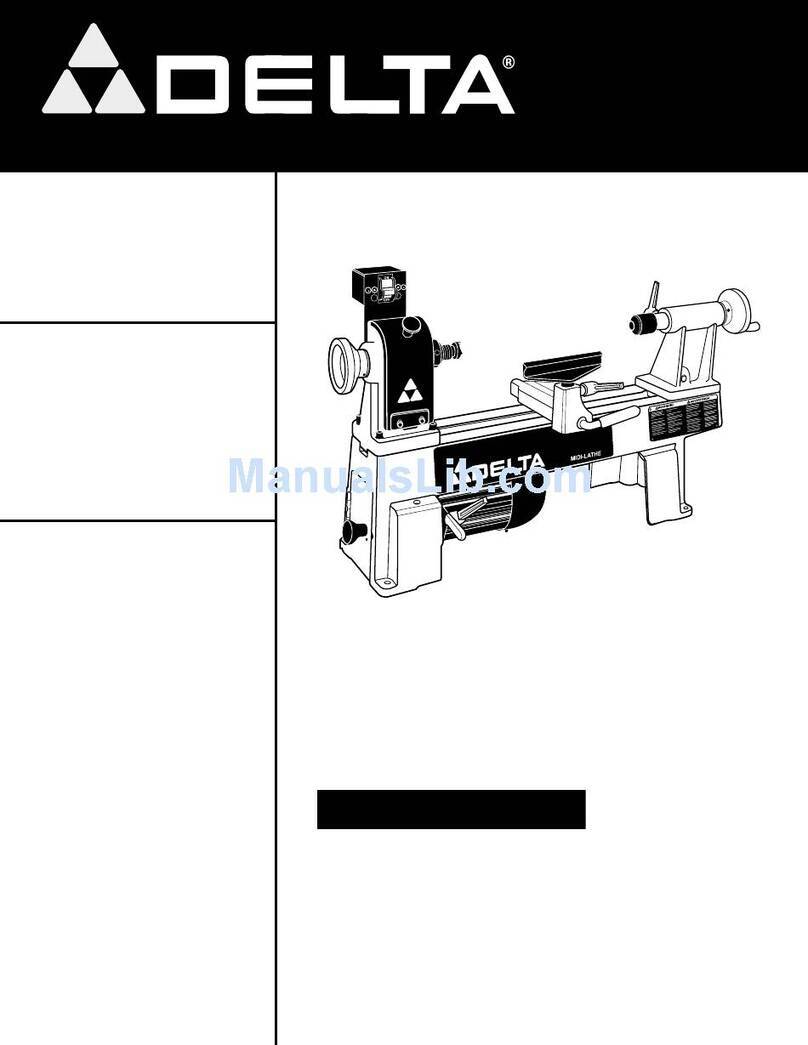
Delta
Delta LA200 instruction manual
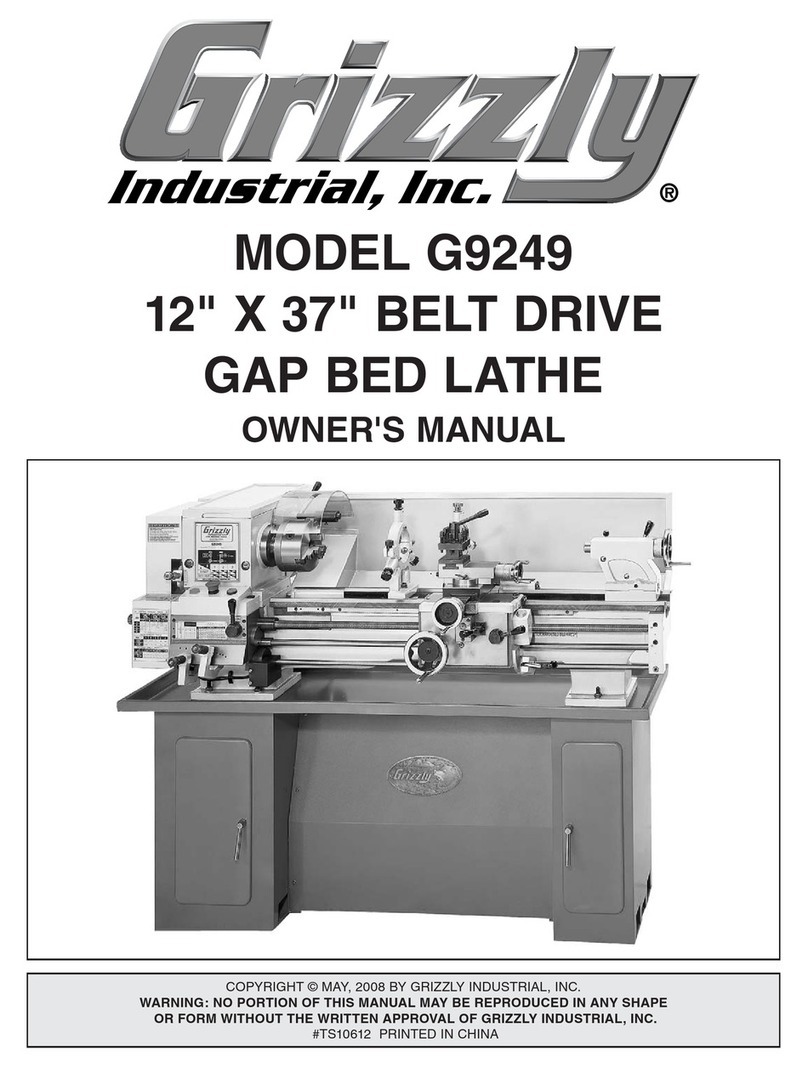
Grizzly
Grizzly G9249 owner's manual
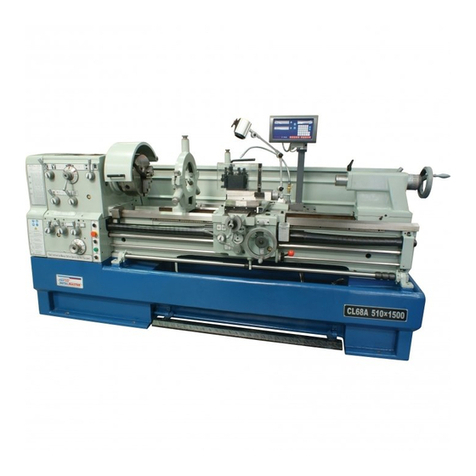
Hafco Metalmaster
Hafco Metalmaster CL-68A instruction manual

Baileigh Industrial
Baileigh Industrial SR-5016 Operator's manual
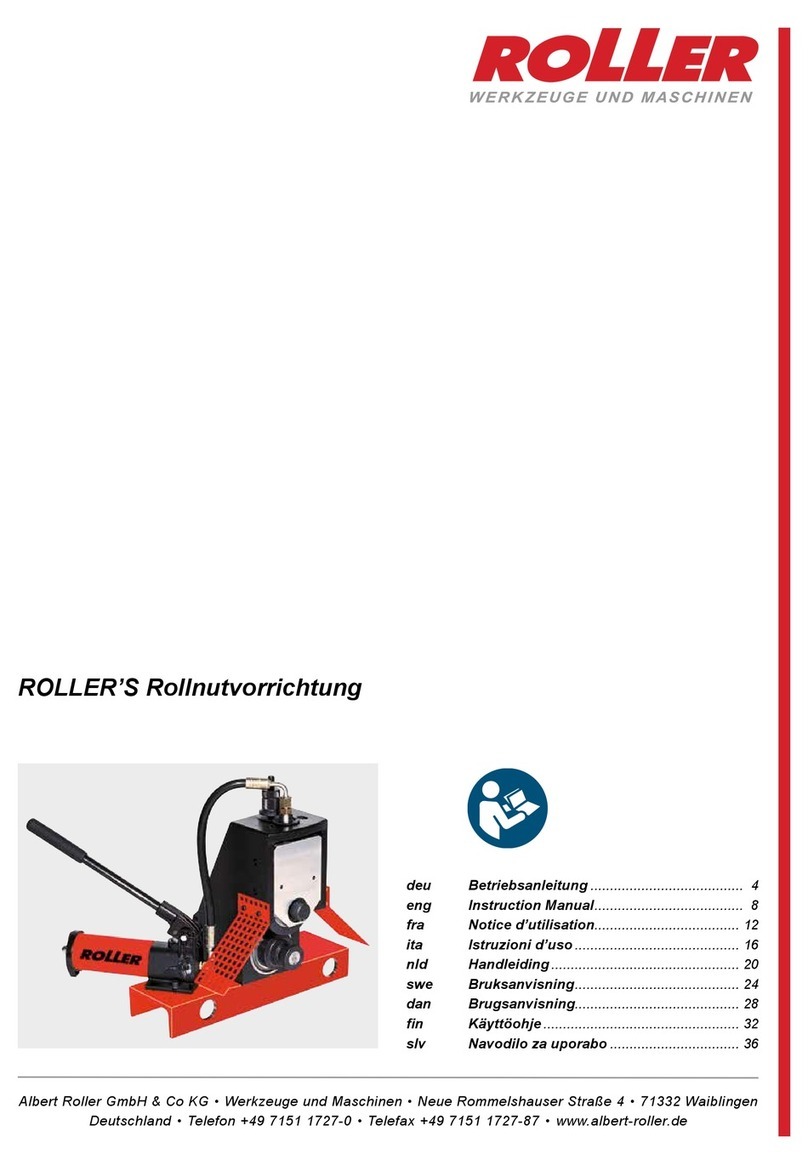
Roller
Roller King 1,25 Series instruction manual
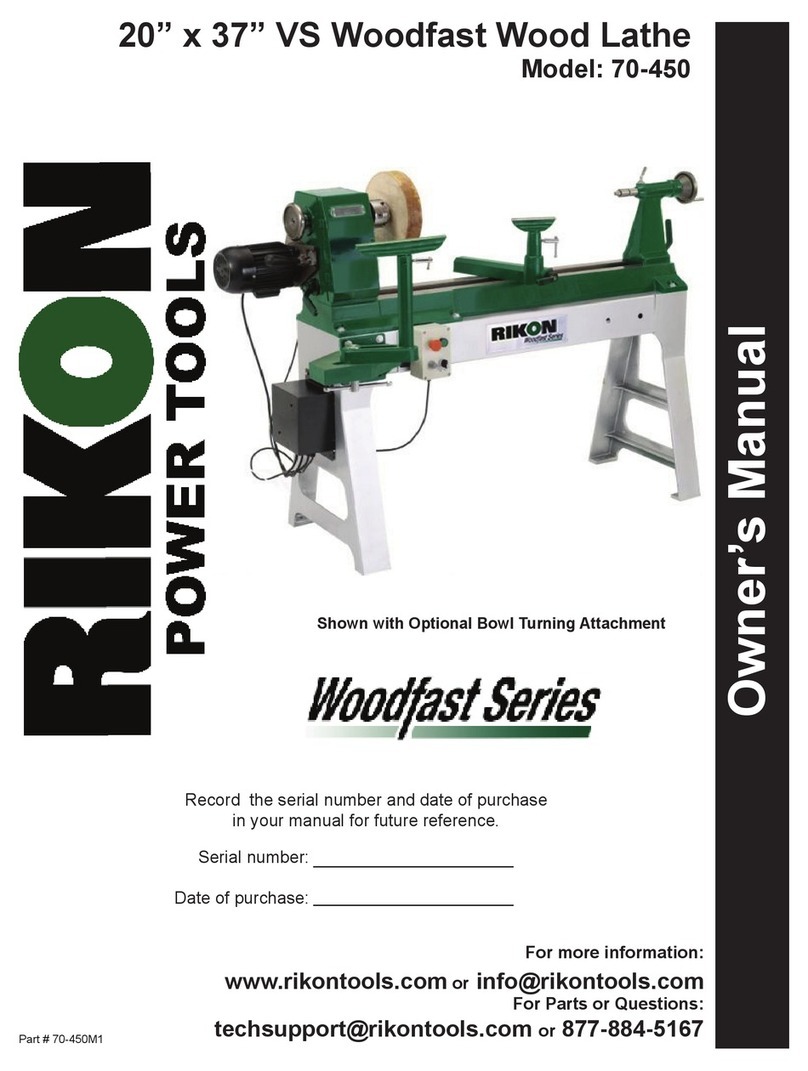
Rikon Power Tools
Rikon Power Tools Woodfast 70-450 owner's manual

